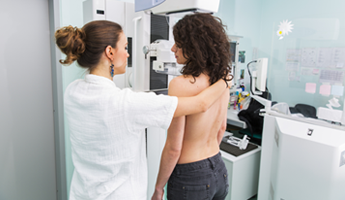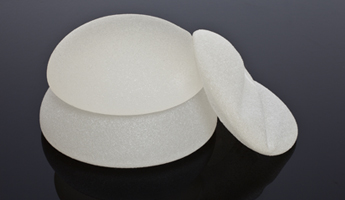The suitability for implant reconstruction would be assessed by your surgeon and the likely outcomes would be discussed. The approach to reconstruction could be staged (i.e. involve more than one operation) depending on the mutually agreed expected outcome and the initial breast size and shape. Similarly, the safety of nipple preservation would be discussed with you.
The different approaches to implant reconstruction are described below:
One-stage implant reconstruction
Breast reconstruction with an implant after mastectomy for breast cancer has traditionally required two-stages or requires multi-step inflation of implant-expander after the first surgery. One-stage implant reconstruction allows for reconstruction of the breast mound in selected group of patients in one operation. This approach is best suited for patients with good preservation of the breast skin after mastectomy. A permanent implant is inserted immediately following the mastectomy, obviating the need for the initial placement of a tissue expander and subsequent expansion process.
Placing the Implant
The mastectomy for breast cancer and the reconstruction with implant is performed at the same time as one surgery. The surgeon will discuss the scarring pattern with you during your initial appointment and will also discuss the implant size and shape keeping in mind your wishes and what is thought to be reasonable for you. After performing skin-sparing mastectomy, the implant of desired volume is positioned on the chest wall behind the chest wall muscle.
This can be achieved in women with relatively big and droopy breasts who wish to be made smaller after reconstruction. Your surgeon will discuss this option, if feasible, with you. This requires placing an anchor shaped scar on your breast and the excess skin is tucked inside to support the implant.
One stage implant reconstruction can be also be achieved in women with small and non-droopy breasts with the use of acellular dermal matrix (ADM) that is an animal product (porcine or bovine), whereby the surgeon can place a permanent implant of the desired definitive volume during the initial surgery, provided the amount and quality of the breast skin remaining after mastectomy can accommodate the volume. Please inform your surgeon if you have any personal or religious beliefs with regards to use of animal product ( please feel free to request for more information on the product that is being used). This product (ADM) develops blood supply from the surrounding body issues after few weeks and it is not usually possible to remove it once it has integrated.
The patient is likely to have the definitive breast volume and approximate shape after the first operation. Depending on the quality of the result after allowing the initial reconstruction to settle and heal for a few months, a second surgery may be required in order to achieve minor adjustments if judged reasonable by your surgeon.
Nipple-areola reconstruction could be considered a few months after when the reconstruction has healed and settled down. For patients with a unilateral breast reconstruction, it is very common to require an adjustment procedure on the opposite breast (such as an augmentation, reduction) in order to achieve better symmetry.
For patients undergoing bilateral reconstruction, symmetry using implants is easier to achieve and therefor patients undergoing bilateral mastectomy are good candidates for this type of surgery.
Who are the potential candidates?
One-stage implant reconstruction is a good option for women who
Do not have sufficient tissue elsewhere (eg. Back or tummy) to allow reconstruction using flaps
Do not desire to have flap operation due to scarring involved or the length of recovery period
Agree to have operation on the opposite breast to achieve symmetry if needed.
Two-stage implant reconstruction
This approach (in contrast to one-stage implant reconstruction) requires at least two operations. The first surgery involves removing the breast tissue (mastectomy) and placing a tissue expander (balloon/temporary expandable implant) behind the chest wall muscle (with or without ADM). This is then followed by gradual expansion of the expander in the out-patient setting. The expansion does not start for at least 3 weeks after surgery to allow the wound to start healing. Once the desired expansion (guided by your surgeon and your desires) is achieved, the next surgery to replace the expander with the definitive silicone implant is planned.
This procedure is not considered a good option for women:
Undergoing delayed reconstruction due to loss of the breast skin during mastectomy.
Who have had radiotherapy to their breast.
Who are overweight, BMI greater than 35.
Who smoke or are diabetic.
If you have objection to use of ADM.
Please click below to read more information on implant reconstruction
Advice and risks associated with Breast Reconstruction with Implants

Do you have breast symptoms or wish to discuss treatment for breast cancer or consider reconstruction?
Consultation Process ›
Not happy with the size or shape of your breasts?
Find out more ›